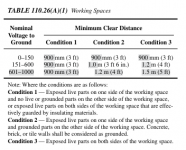hhsting
Senior Member
- Location
- Glen bunie, md, us
- Occupation
- Junior plan reviewer
Please see attached sketch. The large equipment switchboard 2000A 277/480V in the attached sketch is in main electrical room with 225kva transformer 480v to 208/120V, 150kva transformer 480v to 208/120v, and bunch of 277/480V and 120/208V three phase panelboards.
I an wondering would the egress from working space be in compliance with NEC 2017 section 110.26(C)(2) or not? I am thinking 110.26(C)(b) is met but then not sure since on the other side of switchboard where transformer T4 is the door is way at the end

I an wondering would the egress from working space be in compliance with NEC 2017 section 110.26(C)(2) or not? I am thinking 110.26(C)(b) is met but then not sure since on the other side of switchboard where transformer T4 is the door is way at the end



